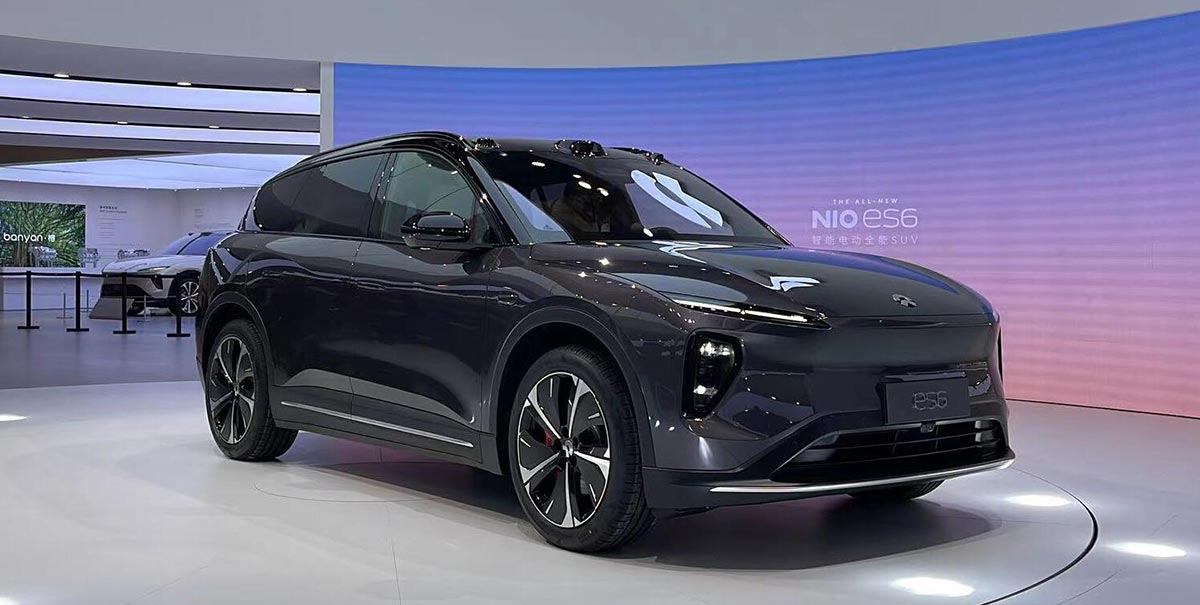การผลิตรายวันของ Nio 300+ ยานพาหนะ ES6, การประชุมเชิงปฏิบัติการบางแห่งที่ใช้กะคู่
โรงงาน F1 ของ Nio หยุดการผลิตเป็นเวลาห้าวันระหว่างเดือนกรกฎาคม 29 และสิงหาคม 2 เพื่อผ่านการอัพเกรดสายการผลิต, ตามสื่อท้องถิ่น.

(ภาพ: NIO es6s)
หลายคนสงสัยเกี่ยวกับ Nio's (สวทช.: สนช.) การผลิตในโรงงาน, แต่รถยนต์ไฟฟ้า (อีวี) Maker เปิดเผยเพียงเล็กน้อยเกี่ยวกับเรื่องนั้น. เดี๋ยวนี้, รายงานใหม่ให้ความกระจ่าง.
Nio กําลังเห็นอย่างน้อย 300 ES6s ออกจากสายการผลิตทุกวัน, และเวิร์กช็อปบางแห่งได้เปลี่ยนจากการผลิตกะเดียวเป็นการผลิตสองกะ, สื่อท้องถิ่น Caixin กล่าวในรายงาน (เบื้องหลังเพย์วอลล์) วันนี้, อ้างถึงบุคคลที่คุ้นเคยกับสายการผลิตของบริษัท.
นอกจากนี้, โรงงาน F1 ของ Nio หยุดการผลิตเป็นเวลาห้าวันระหว่างเดือนกรกฎาคม 29 และสิงหาคม 2 เพื่อผ่านการอัพเกรดสายการผลิต, ตามรายงาน.
ดูเหมือนว่าจะอธิบายได้ว่าเหตุใดการจดทะเบียนประกันภัยสําหรับรถยนต์ Nio ในประเทศจีนจึงลดลงในช่วงสองสัปดาห์ที่ผ่านมา, แม้ว่าจะเสร็จสิ้นการเปิดตัวรุ่นใหม่และการเปลี่ยนผ่านไปยัง NT 2.0 แพลตฟอร์มสําหรับทุกรุ่นยกเว้น EC6.
ในสัปดาห์แรกของเดือนสิงหาคม, ตั้งแต่เดือนกรกฎาคม 31 ถึงเดือนสิงหาคม 6, การจดทะเบียนประกันภัยของยานพาหนะ Nio ในประเทศจีนอยู่ที่ 4,300 หน่วย, ลง 20.37 เปอร์เซ็นต์จาก 5,400 หน่วยในสัปดาห์ก่อนหน้า, ตามข้อมูลที่แชร์ก่อนหน้านี้โดย Li Auto (แนสแด็ก: หลี่).
ในสัปดาห์ที่สองของเดือนสิงหาคม, ตั้งแต่เดือนสิงหาคม 7 ถึงเดือนสิงหาคม 13, การจดทะเบียนประกันภัยของยานพาหนะ Nio ในประเทศจีนลดลงอีกเป็น 3,300 หน่วย, ลง 23.26 เปอร์เซ็นต์จากสัปดาห์ก่อนหน้า.
ยานพาหนะของ Nio ผลิตที่โรงงานสองแห่งในเหอเฟย, มณฑลอานฮุย, ทางตะวันออกของจีน, รวมถึงโรงงาน F1, ฐานการผลิตขั้นสูงของ JAC Nio, และโรงงาน F2 ใน NeoPark.
แรกเริ่ม, ทั้ง ES6 และ ES8 รุ่นเก่าผลิตที่โรงงาน F1, แต่เพื่อให้มั่นใจในกําลังการผลิต, โรงงาน F1 กําลังผลิต ES6 ใหม่เป็นหลัก, ในขณะที่การผลิต ES8 ใหม่ถูกย้ายไปที่โรงงาน F2, ตาม Caixin.
Nio เปิดตัว ES6 ใหม่, ตาม NT ล่าสุด 2.0 แท่น, ในประเทศจีนในเดือนพฤษภาคม 24, โดยเริ่มส่งมอบในคืนของการเปิดตัว.
บริษัทเปิดตัว ET5 Touring ในเดือนมิถุนายน 15, และเริ่มส่งมอบในเดือนมิถุนายน 16.
การส่งมอบ ES8 ใหม่ในประเทศจีนเริ่มขึ้นในเดือนมิถุนายน 28, และ Nio เรือธง SUV เปิดตัวในเดือนธันวาคม 24, 2022 ในวันนีโอ 2022.
ด้วยกําลังการผลิตที่เพิ่มขึ้นหลังจากการเปิดตัวรุ่นใหม่อย่างเข้มข้น, Nio ส่งบันทึก 20,462 ยานพาหนะในเดือนกรกฎาคม, เป็นครั้งแรกนับตั้งแต่เริ่มก่อตั้งที่ได้เห็นการส่งมอบเกิน 20,000 รอย.
Nio ES6 ส่งมอบ 11,118 หน่วยในเดือนกรกฎาคม, มีส่วนร่วม 54.33 เปอร์เซ็นต์ของการจัดส่งรายเดือนของ Nio, ข้อมูลที่ตรวจสอบโดย CnEVPost แสดงให้เห็น.
ET5 Touring ส่งมอบ 3,662 หน่วยในเดือนกรกฎาคม, มีส่วนร่วม 17.89 เปอร์เซ็นต์ของการส่งมอบของ Nio ในเดือน.
Nio ES8 ส่งมอบ 1,917 หน่วยในเดือนกรกฎาคม, a 226.02 เปอร์เซ็นต์เพิ่มขึ้นจากเดือนมิถุนายนและทําสถิติสูงสุดใหม่นับตั้งแต่เดือนธันวาคม 2021.
นอกเหนือจากการผลิตจากโรงงาน, รายงานล่าสุดของ Caixin ยังกล่าวถึงค่าใช้จ่ายของสถานีสลับแบตเตอรี่ของ Nio.
ต้นทุนการลงทุนของ Nio สําหรับสถานีแลกเปลี่ยนแบตเตอรี่เดียวเฉลี่ยระหว่าง RMB 4 ล้าน ($550,000) และหยวน 5 ล้าน, และจะลงทุนมากกว่า RMB 4 พันล้านในสิ่งอํานวยความสะดวกเหล่านี้ใน 2023, รายงานระบุว่า, อ้างแหล่งข่าวจากศูนย์วิจัยและเทคโนโลยียานยนต์จีน (คาตาร์ก).
ค่าใช้จ่ายในการลงทุนสําหรับสถานีสลับแบตเตอรี่รวมถึงค่าใช้จ่ายของไซต์, ค่าใช้จ่ายในการได้มาซึ่งอุปกรณ์, ค่าก่อสร้าง, ค่าแบตเตอรี่, และต้นทุนการดําเนินงานรวมถึงการบํารุงรักษาอุปกรณ์และการซื้อไฟฟ้า, รายงานระบุว่า.
Nio ตั้งเป้าที่จะเพิ่ม 1,000 สถานีสลับแบตเตอรี่ใน 2023, นํายอดรวมของสิ่งอํานวยความสะดวกเป็น 2,300 สิ้นปี.
ณ เดือนสิงหาคม 21, Nio มี 1,673 สถานีเปลี่ยนแบตเตอรี่ในประเทศจีน, ข้อมูลที่ตรวจสอบโดย CnEVPost แสดงให้เห็น.
ตั้งแต่สถานีสลับแบตเตอรี่แห่งแรกของ Nio เริ่มใช้งาน, บริษัทฯ ได้ให้มากกว่า 27 บริการเปลี่ยนแบตเตอรี่ล้านครั้ง.
โดยเฉพาะอย่างยิ่ง, Nio ไม่เคยเปิดเผยค่าใช้จ่ายของสถานีสลับแบตเตอรี่แต่ละแห่ง, แม้ว่ารายงานก่อนหน้านี้จะแนะนําว่าสถานีสลับแบตเตอรี่รุ่นแรกแต่ละแห่งมีราคาหยวน 3 ล้านที่จะสร้าง, ด้วยค่าใช้จ่ายของโรงงานรุ่นที่สองที่ลดลงเหลือ RMB 1.5 ล้าน.
ค่าใช้จ่ายของ Nio ในการนําสถานีแลกเปลี่ยนแบตเตอรี่รุ่นที่สองไปใช้งานนั้นประมาณ RMB 2.5 ล้าน, และรายจ่ายด้านทุนที่เกี่ยวข้องกับสิ่งอํานวยความสะดวกเหล่านี้จะไม่นํามาซึ่งแรงกดดันทางการเงิน, หยูเสี่ยวลี่, นักวิเคราะห์ที่โบรกเกอร์จีน Industrial Securities, กล่าวในเดือนตุลาคม 2021 บันทึกการวิจัย.

 รถยนต์ในประเทศจีน
รถยนต์ในประเทศจีน